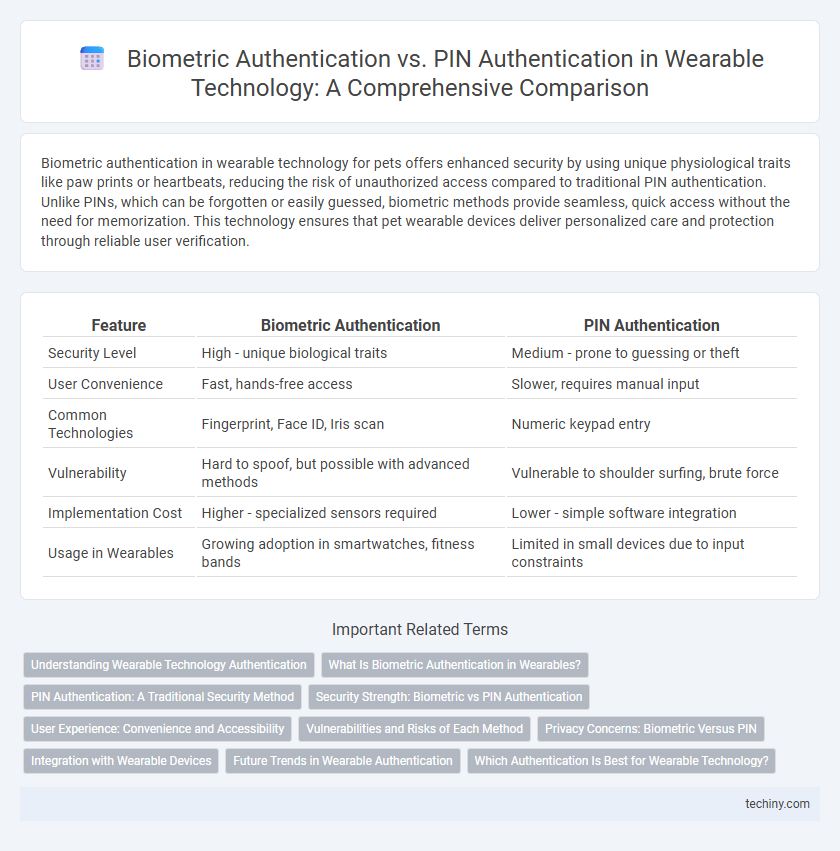Biometric authentication in wearable technology for pets offers enhanced security by using unique physiological traits like paw prints or heartbeats, reducing the risk of unauthorized access compared to traditional PIN authentication. Unlike PINs, which can be forgotten or easily guessed, biometric methods provide seamless, quick access without the need for memorization. This technology ensures that pet wearable devices deliver personalized care and protection through reliable user verification.
Table of Comparison
| Feature | Biometric Authentication | PIN Authentication |
|---|---|---|
| Security Level | High - unique biological traits | Medium - prone to guessing or theft |
| User Convenience | Fast, hands-free access | Slower, requires manual input |
| Common Technologies | Fingerprint, Face ID, Iris scan | Numeric keypad entry |
| Vulnerability | Hard to spoof, but possible with advanced methods | Vulnerable to shoulder surfing, brute force |
| Implementation Cost | Higher - specialized sensors required | Lower - simple software integration |
| Usage in Wearables | Growing adoption in smartwatches, fitness bands | Limited in small devices due to input constraints |
Understanding Wearable Technology Authentication
Biometric authentication in wearable technology leverages unique physiological traits such as fingerprints, heart rate patterns, or iris scans, offering heightened security compared to traditional PIN authentication by reducing the risk of unauthorized access due to stolen or guessed codes. Wearable devices equipped with biometric sensors enable continuous and seamless user verification, enhancing user convenience and data protection simultaneously. In contrast, PIN authentication relies on memorized numeric codes susceptible to interception or replication, making biometrics a more reliable choice for safeguarding sensitive information on wearable platforms.
What Is Biometric Authentication in Wearables?
Biometric authentication in wearables uses unique physiological traits such as fingerprints, heart rate patterns, or facial recognition to verify identity securely and conveniently. Unlike PIN authentication, biometric methods offer continuous, passive verification, enhancing user experience by eliminating the need for manual input. Advanced sensors embedded in smartwatches and fitness trackers enable real-time biometric data collection, improving both security and personalization.
PIN Authentication: A Traditional Security Method
PIN authentication remains a widely adopted traditional security method in wearable technology due to its simplicity and ease of implementation. Despite limitations such as susceptibility to shoulder surfing and brute-force attacks, PINs offer a straightforward user experience without requiring complex hardware. In comparison to biometric options like fingerprint or facial recognition, PIN authentication provides a cost-effective solution suitable for devices with limited processing power and sensor capabilities.
Security Strength: Biometric vs PIN Authentication
Biometric authentication leverages unique physiological traits such as fingerprints, facial recognition, or iris patterns, offering robust security by reducing risks associated with stolen or guessed credentials. PIN authentication relies on user-generated numeric codes, which are vulnerable to guessing, shoulder surfing, and brute-force attacks, resulting in comparatively weaker security. Advanced wearable devices utilize biometric sensors that provide continuous, real-time identity verification, significantly enhancing protection against unauthorized access.
User Experience: Convenience and Accessibility
Biometric authentication in wearable technology offers superior convenience and accessibility by enabling quick, contactless verification through fingerprints, facial recognition, or heart rate patterns, eliminating the need to remember and input PIN codes. Unlike PIN authentication, which can be cumbersome on small screens and vulnerable to shoulder surfing, biometrics streamline user interaction and enhance security simultaneously. This seamless integration improves overall user experience by reducing authentication time and minimizing friction during everyday wearable device use.
Vulnerabilities and Risks of Each Method
Biometric authentication in wearable technology faces vulnerabilities such as spoofing attacks, sensor hacking, and data breaches compromising fingerprint or facial recognition data. PIN authentication, while simpler, is susceptible to risks like shoulder surfing, brute force attacks, and user negligence in choosing weak or reused codes. Balancing security measures involves mitigating the biometric risks through encryption and liveness detection, while enforcing complex PIN policies and automatic lockouts after failed attempts.
Privacy Concerns: Biometric Versus PIN
Biometric authentication uses unique biological traits such as fingerprints or facial recognition, enhancing security by minimizing the risk of unauthorized access linked to stolen or guessed credentials. PIN authentication relies on user-generated numeric codes, which can be vulnerable to interception, guessing, or shoulder surfing, raising concerns about data breaches. Privacy concerns with biometrics involve the permanent nature of biometric data and the potential misuse or unauthorized storage of sensitive personal information.
Integration with Wearable Devices
Biometric authentication integrates seamlessly with wearable technology by utilizing fingerprint sensors, facial recognition, or heart rate patterns directly on devices like smartwatches and fitness trackers for enhanced security and convenience. PIN authentication relies on manual entry, which can be cumbersome on small screens and less secure due to risks of observation or forgotten codes. Wearable devices equipped with biometric sensors offer continuous, passive authentication, improving user experience and reducing friction compared to traditional PIN methods.
Future Trends in Wearable Authentication
Biometric authentication in wearable technology is rapidly evolving with advancements in sensor accuracy and AI-driven pattern recognition, enabling more secure and seamless user verification compared to traditional PIN authentication. Emerging trends include multimodal biometrics combining fingerprint, heartbeat, and gait analysis to enhance precision and reduce spoofing risks. Future wearable devices will likely integrate continuous authentication systems, leveraging real-time biometric data to provide adaptive security tailored to individual user behavior.
Which Authentication Is Best for Wearable Technology?
Biometric authentication offers enhanced security for wearable technology by utilizing unique physiological traits such as fingerprints, heart rate patterns, or facial recognition, reducing the risk of unauthorized access compared to traditional PINs. PIN authentication, while simpler to implement and remember, is vulnerable to being easily guessed or stolen, making it less reliable for devices that require constant, seamless protection. The integration of biometric methods aligns better with the continuous, hands-free nature of wearables, promoting both convenience and robust security.
Biometric Authentication vs PIN Authentication Infographic

 techiny.com
techiny.com